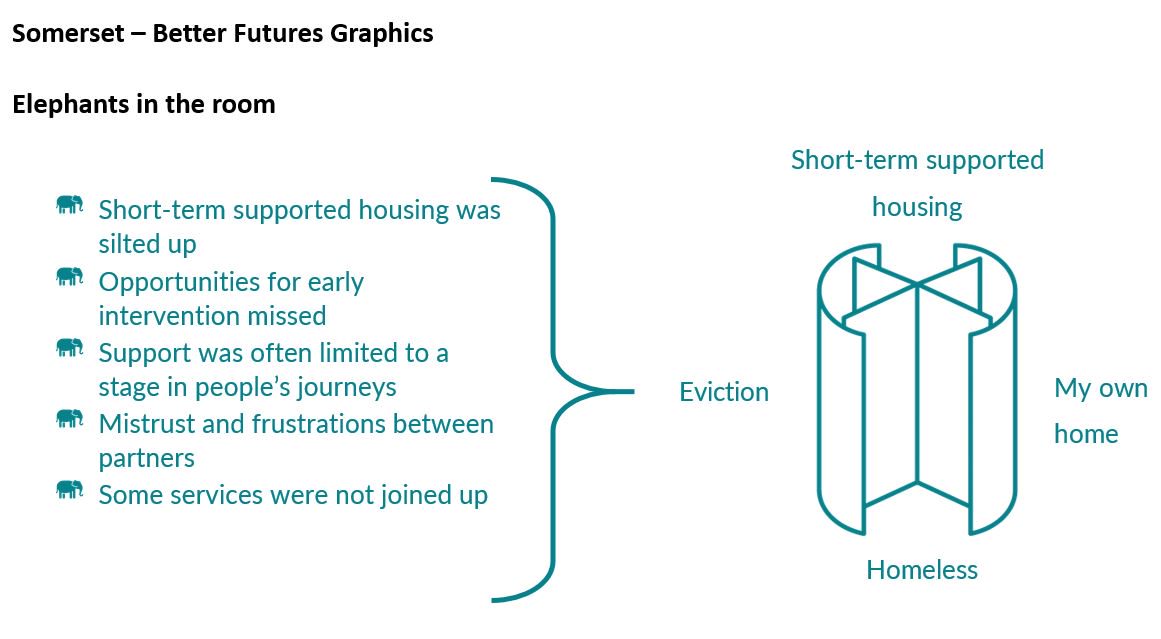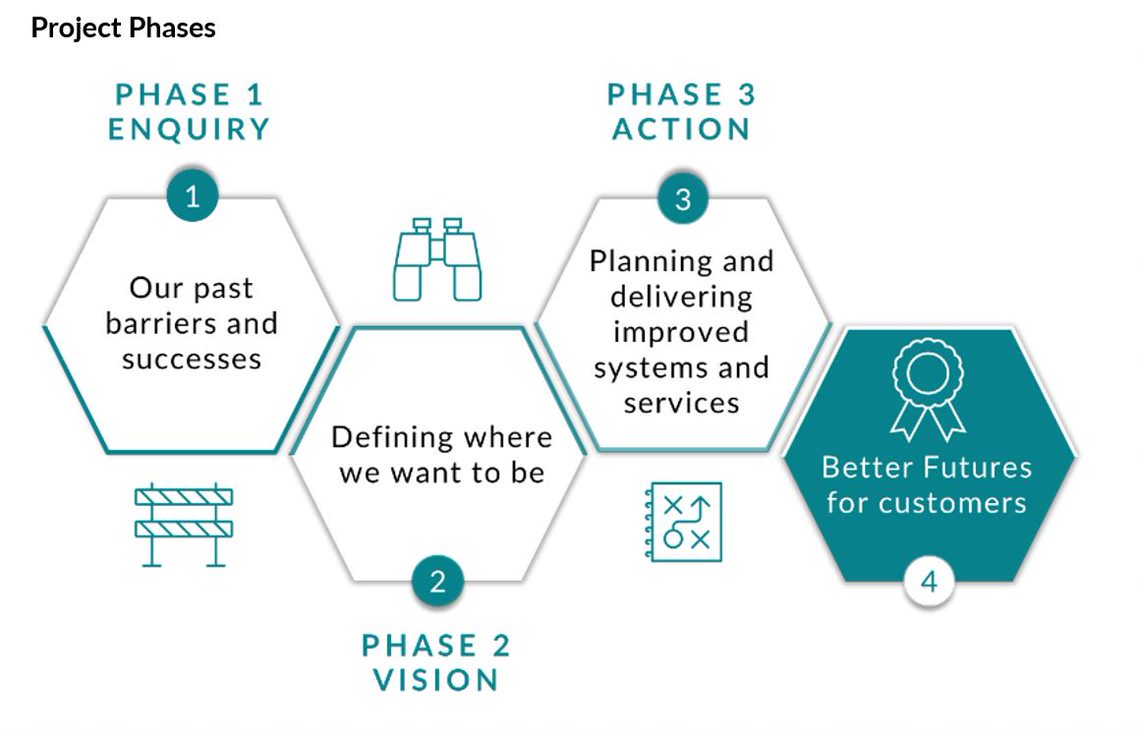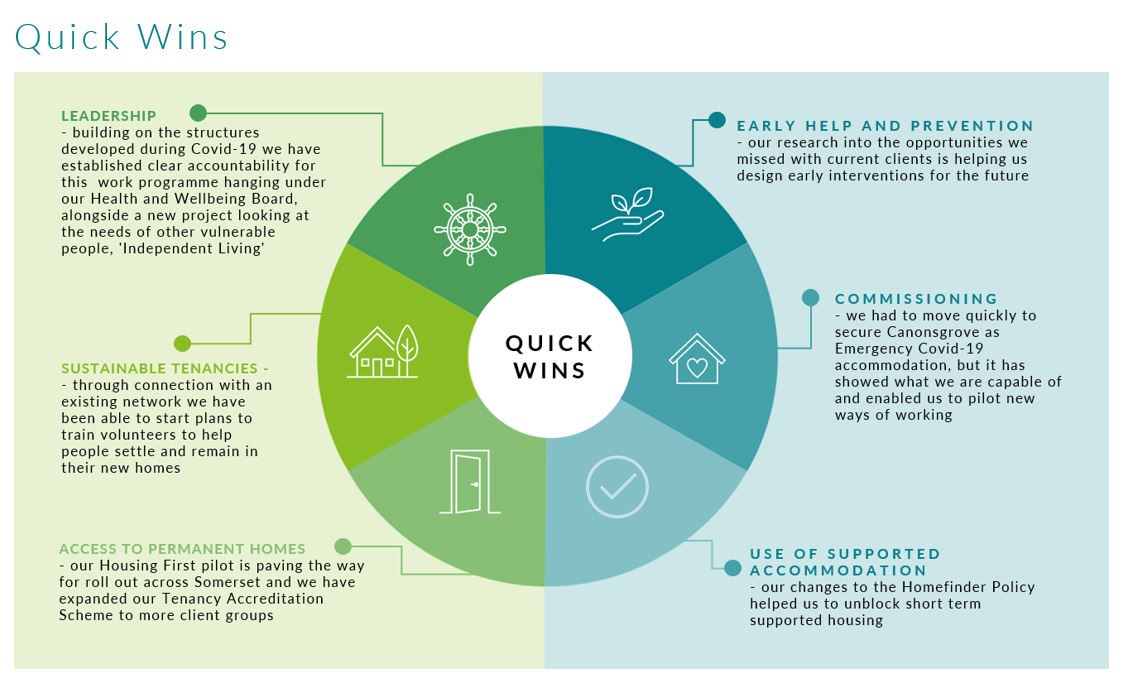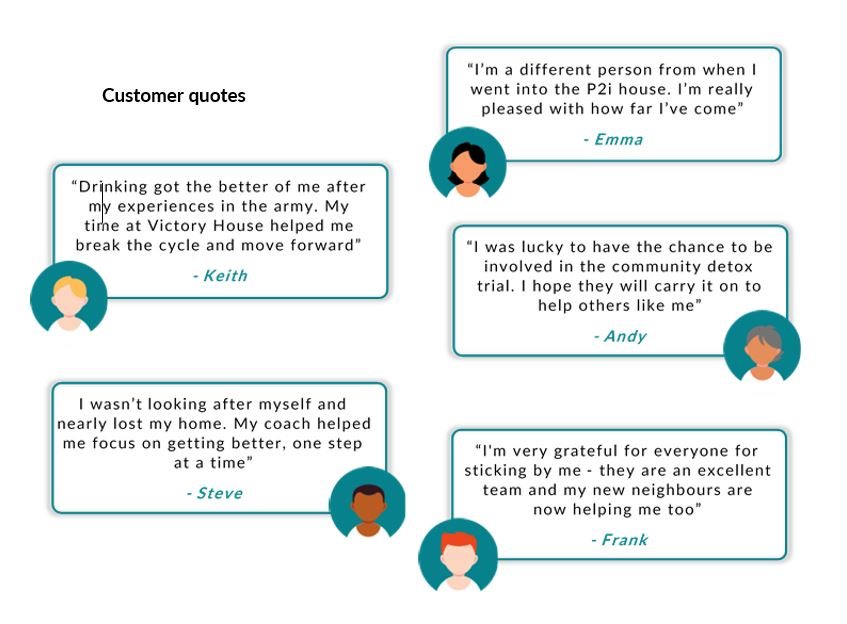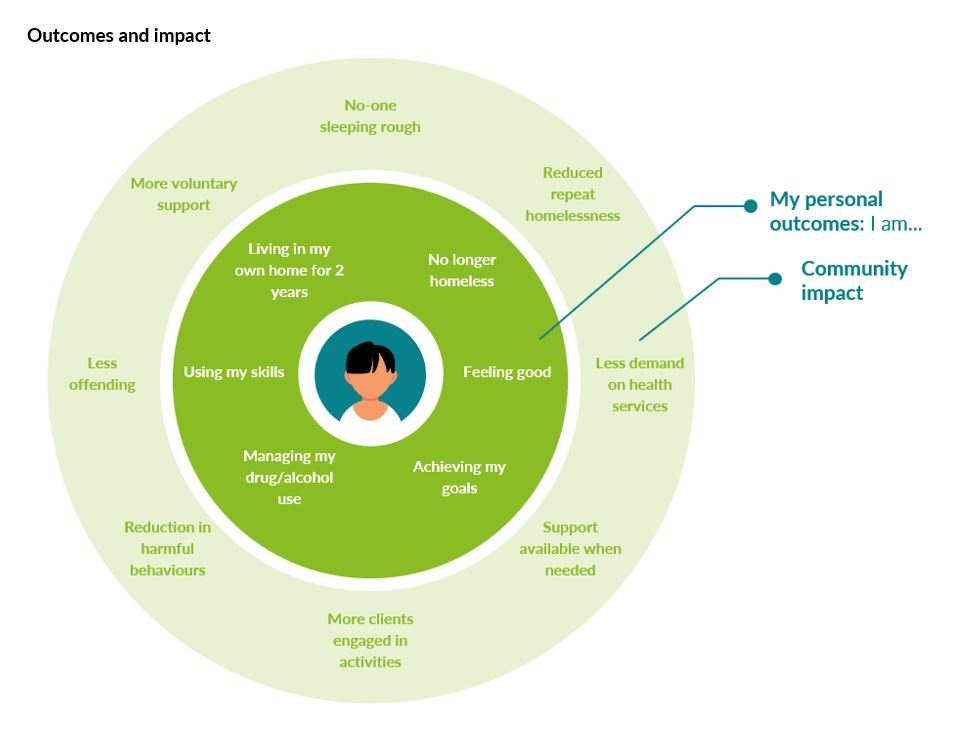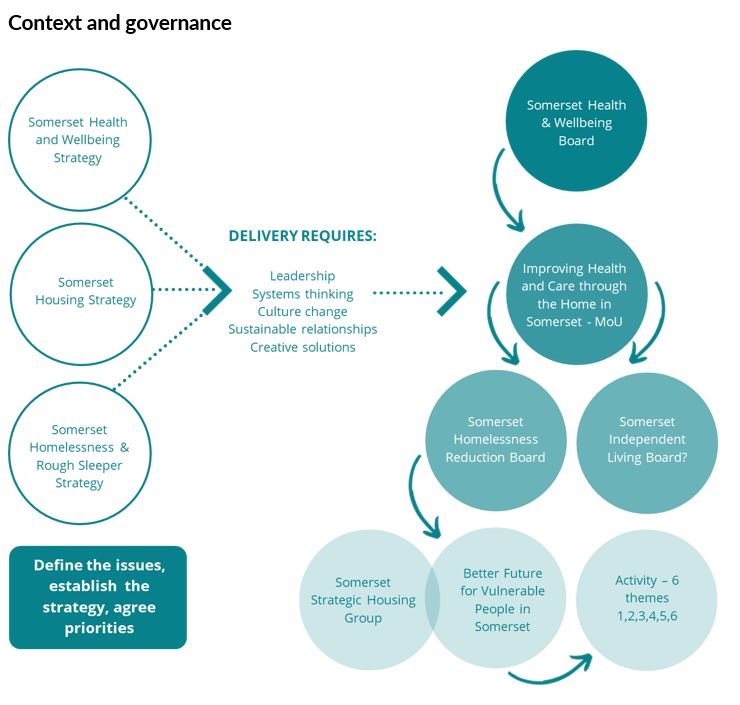Frustrated at the rising numbers of vulnerable people struggling to access homes and support that met their needs, the Somerset Strategic Housing Group (SSHG) decided we needed to crack the problem.
At a glance
Housing Advisers Programme case study
2019/20 cohort
Executive summary
Before we started on the Better Futures project vulnerable people across Somerset were struggling to navigate their way between health, care and housing services. Partners were not always pulling together to help people access the homes and support that met their needs. This had to change and we all knew we needed to flush out the problems but wanted to focus on the good practice that already existed, in Somerset and elsewhere.
COVID-19 created a new barrier to resolving the issue – changing culture and practice without being able to communicate face to face was never going to be easy. Undeterred we moved forward ‘online’, exposing the ‘elephants in the room’ and celebrating the positives; developing a draft vision based on ‘better futures’ case studies and engaging partners in clarifying our vision and developing an action plan to deliver this.
Quick wins were made – as well as starting to unblock short term supported housing (see statistic in outbox) we have piloted new ways of working in our COVID-19 emergency accommodation and built on the Covid-19 Homelessness Cell arrangements to develop a new leadership and governance structure to manage the delivery of our vision. In fact our collective response to the pandemic created a springboard for the project; we seized the moment and harnessed the renewed energy to get creative and break down any barriers in the way.
It is too early to be sure but we believe that we will be able to demonstrate a positive impact from the project through monitoring individual outcomes as well as the community metrics we have identified. This could realise cost reductions across the health, care and housing system, and for other community services, providing the foundation of strategic integrated commissioning. Most importantly, it will also enable Better Futures for this vulnerable customer group.
Challenge and context
Frustrated at the rising numbers of vulnerable people struggling to access homes and support that met their needs, the Somerset Strategic Housing Group (SSHG) decided we needed to crack the problem. But where to start? And we knew we were unable to solve it alone.
Against a backdrop of system pressures, not unlike those in other two-tier counties, there were barriers in the way of getting people the help they needed to move forward on their journeys. Housing supply generally was stretched, in part due to the impact of the Hinkley Point C construction on demand for private rented housing. Funding for support had been reduced over the years. Vulnerable people were being coerced to transport drugs through ‘County Lines’ and to allow the dealers to use their homes, often resulting in eviction. There was evidence of increased numbers and complexity of needs amongst the people presenting as homeless and those living on the street.
Before COVID-19 we were:
- Missing early intervention and homelessness prevention opportunities.
- Not making best use of short term supported accommodation – it was silted up with people ready to move-on.
- Failing to support people along their journeys as and when needed.
- Not all working well together in partnership and sometimes mistrustful others.
Figure 1.
The result? People were falling through cracks between A&E, mental health and drug/alcohol services and between supported accommodation and floating support; getting stuck in the revolving door of homelessness and rough sleeping and numbers were rising.
What we did
Figure 2.
We wanted the project to focus on the positives and strengths of our current arrangements, so we used an ‘Appreciative Inquiry’ approach. After exposing the ‘elephants in the room’ above we moved swiftly on to look at what has worked well in Somerset and what it was that made it successful. We also pulled together partners experience of solutions from elsewhere.
Developing a shared vision without being able to gather everyone in a room was never going to be easy. We hit on the idea of telling the stories of customers journeys to their own idealistic ‘Better Future’. We underpinned the stories with the key principles of the ideal service arrangements – desired outcomes for individuals and the community as a whole; the support needed to achieve the outcomes and how services need to work to ensure success. The stories were shared with partners and we held a virtual workshop so that everyone could contribute to the final vision.
With everyone fired up for change following the workshop we quickly moved on to the action planning phase. We recruited volunteers to join planning groups for the different themes we had identified through the enquiry phase. Using small group online workshops, a series of theme plans were developed and collated for approval by SSHG. Some of these groups are moving forward as action groups to help deliver the vision.
The difference we made
Building on some projects already started (e.g. the Homefinder Somerset policy review) and the new approaches developed during COVID-19 we achieved some quick wins. Examples under each of our Better Futures themes are shown in the diagram below:
Figure 3.
Figure 4.
We have also witnessed a new culture of shared responsibility for delivering the actions needed to achieve the vision. The new approaches piloted in the COVID-19 emergency accommodation and the joint ownership of the response by members of the COVID-19 Homelessness Cell showed that we could achieve more by working better together and this has flowed through to our Better Futures action plan.
What's next?
The desired outcomes for individuals, as monitored by them with the support of their key worker, will be tracked by support agencies. The key measures for individual outcomes are shown in the middle band of diagram below. Achievement of these outcomes will be the direct measure of success of the project as a whole.
We expect the new approach to have a wider impact on service demand, potentially generating savings which could be reinvested in further preventative solutions. The work has laid the foundations to aspire to a future of prevention focussed, integrated commissioning across health, care and housing. If we are successful, our community metrics shown in the outer band of the diagram, including reduction in rough sleeping, repeat homelessness, demand for health services, offending and harmful behaviours, will have a positive impact on housing, health, public health, police and probation services. The engagement of customers in education, training, employment and volunteering will impact on their mental health as well and potentially reducing reliance on welfare benefits.
Figure 5.
The new governance arrangements in place, with the establishment of a new Homelessness Reduction Board reporting up to the Health and Wellbeing Board, will ensure we maintain our focus and drive forwards to Better Futures. The Better Futures programme has also been included in our new Memorandum of Understanding between health, social care and housing authorities, sitting alongside a new Independent Living project aimed at improving housing and support arrangements for older people and people with physical, sensory or learning difficulties. As we said when we started the project if we can crack this one, we can apply our learning to other vulnerable groups.
Lessons learned
Despite the disruption and changes to the way we work resulting from COVID-19, the project has progressed at pace and with enthusiasm, commitment and ‘buy-in’ of partners. We believe this has been secured through the:
- Early engagement of all partners – we interviewed over 40 people from 25 different agencies in the enquiry phase.
- Use of the Appreciative Inquiry approach – this led people away from blaming others for the problem to celebrating successes and seeking positive solutions.
- Actioning some quick wins (see examples above) – this demonstrated our commitment to rise to the challenge and change things for the better.
- Checking in with stakeholders regularly – was the vision right? Were we on the right lines with the action plan?
- Adapting quickly to the changed world during COVID-19 – all of our interviews were conducted remotely and workshops were virtual, yet partners said they felt fully listened to and involved in the project.
- Crisis creates opportunity – the response Everyone In to COVID-19 created momentum and drive and we took advantage of that in developing the Better Futures project.
- Introduction of new, robust governance arrangements feeding up to the Health and Wellbeing Board and thus ensuring that the joint responsibilities of housing, health and social care/support agencies are appropriately led and managed.
- Positive change is best realised when you develop positive relationships and think systems, not services.
Was there anything that we’d do differently next time? The initial project scope was too big, so we quickly had to scale back. Next time we will focus more clearly at the outset on what is achievable.
Figure 6.
Contact
Mark Leeman, Strategy Specialist: Housing and Communities, Somerset West and Taunton Council. [email protected]

